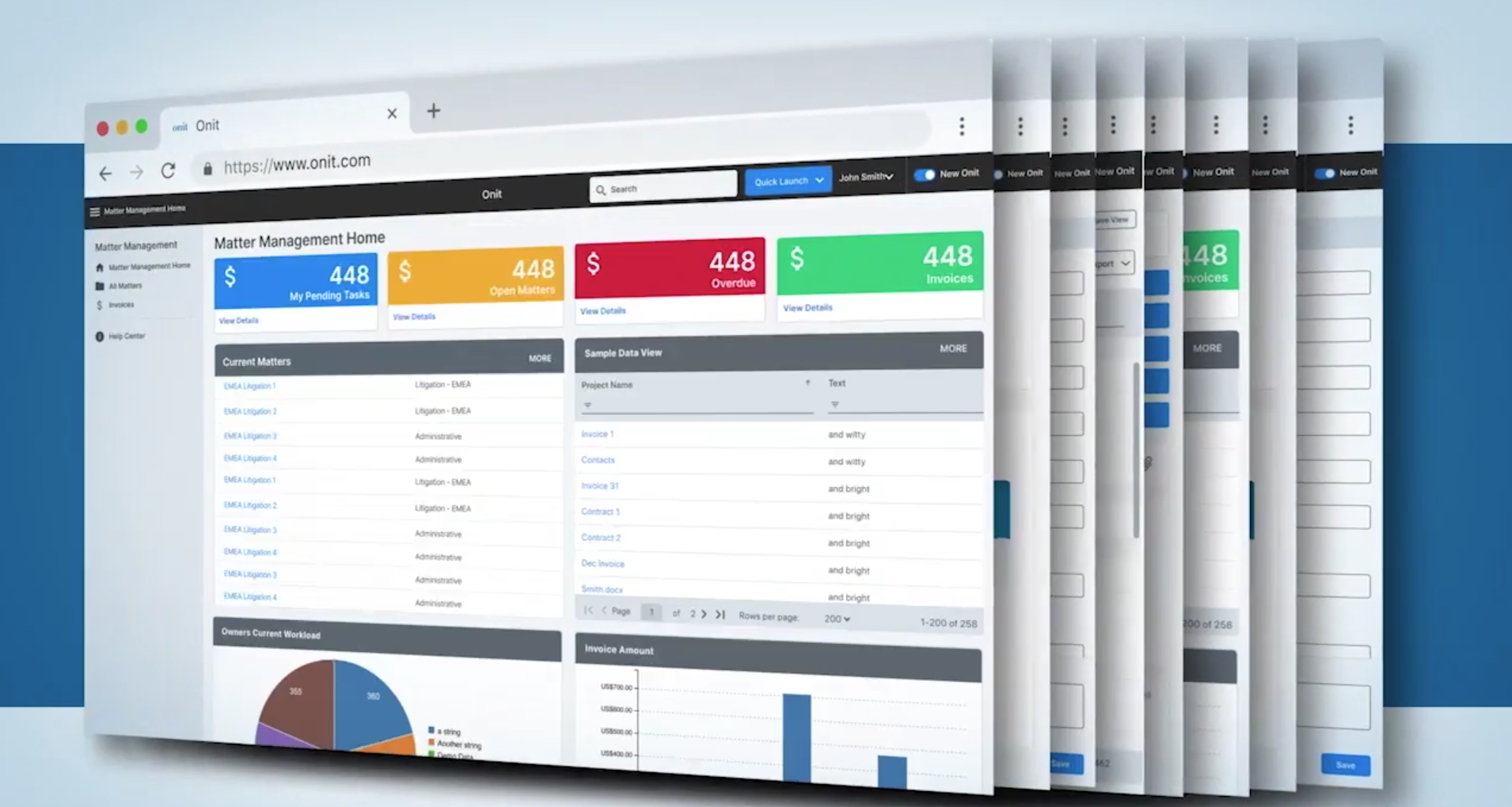
DAS NEUE „NORMAL“ DES RECHTSWESENS
Zweifelsohne waren die letzten 12 Monate hart. Tatsächlich sogar extrem schwierig und stressig. Wir mussten uns schnell anpassen – an eine neue Lebens- und Arbeitsweise, die längst nicht so familiär und angenehm ist wie die, die wir zuvor als selbstverständlich erachtet haben. Das alles geschah mehr oder minder über Nacht und wir mussten es akzeptieren, denn es galt Leben zu retten.
Noch nie gab es eine so schnelle und globale Änderung der Lebensweise. Insbesondere die Art, wie wir arbeiten, erfuhr drastische Einschnitte. Langes Pendeln und ablenkende Büroarbeitsplätze gehören nun der Vergangenheit an. Untersuchungen haben ergeben, dass wir unsere neue Arbeitsweise sogar eigentlich ziemlich mögen: Mehr als 50% der Arbeitnehmer gaben an, auch nach der Pandemie von daheim arbeiten zu wollen.
COVID-19 hat nicht nur dazu geführt, dass Menschen von zu Hause aus arbeiten, sondern auch dazu, dass sie zu unterschiedlichen Zeiten und an unterschiedlichen Orten arbeiten. Da Schulen und Betreuungseinrichtungen geschlossen waren, hatten viele Menschen damit zu kämpfen, ihre Arbeit mit dem Homeschooling, der Pflege von Familienmitgliedern, ehrenamtlichen Tätigkeiten oder anderen Verpflichtungen zu vereinbaren. Dies führte zu einer unvermeidlichen Umstrukturierung des Arbeitstages. Um mithalten zu können, starteten viele ihre Arbeit früher als üblich oder arbeiteten abends und am Wochenende. Durch diese Flexibilität konnten Einige ihre Produktivität maximieren, denn sie waren nicht länger gezwungen, zu traditionellen Geschäftszeiten zu arbeiten. Wenn nicht gerade ein Lockdown stattfindet, entscheiden sich die Mitarbeiter:innen auch dafür, anderorts zu arbeiten. Zwischen den Lockdowns gab es manche Kolleg:innen, die von Cornwall, Polen und Dubai aus gearbeitet haben. Das alles bedeutet, dass ein Großteil der Belegschaft zu anderen Zeiten und an anderen Orten arbeitet.
Diese neue Work-from-Home-Revolution wird enorme Auswirkungen auf viele Branchen haben, aber was bedeutet das für die Rechtsbranche, und vor allem, welche Rolle wird Technologie dabei spielen? Hier sind fünf Legal Tech-Trends, die in den kommenden Monaten und Jahren als Ergebnis der Pandemie hervorgehen werden.
1) ASYNCHRONES ARBEITEN
Anwält:innen müssen asynchrone Kollaborations- und Kommunikationstools einführen, um produktives Arbeiten in Teams zu ermöglichen. Während viele von ihnen schnell synchrone Tools (z.B. Videoanrufe und Instant Messaging) eingeführt haben, wurde der Sprung zu asynchronen Plattformen für echtes Projektmanagement meist nicht gewagt. Immer mehr Anwält:innen werden mit Team-Collaboration-Tools wie Confluence oder Notion sowie mit Projektmanagement-Tools wie Jira, Trello, Asana und Monday experimentieren. Wer weiß – vielleicht sehen wir sogar, dass Teile von agilen Projektvorgehensmodellen, wie tägliche Sprints und Stand-ups, eingeführt werden!
Es ist auch wahrscheinlich, dass dieser Trend das Entwickeln von modernen Matter Management-Tools beschleunigen wird, die sich von Aufzeichnungssystemen zu vollwertigen Engagement- und Collaboration-Systemen entwickeln. Dies wird nicht nur Tools zur Produktivitätssteigerung betreffen: Es wird auch einen Anstieg bei der Nutzung von asynchronen Lernplattformen geben. So kann sichergestellt werden, dass Remote-Mitarbeiter:innen zu einer für sie passenden Zeit Zugang zu Schulungen und Fortbildungen haben.
Nur wer von überall und zu jederzeit auf (juristisches) Know-how zugreifen kann, wird als Remote-Mitarbeiter:in auf dem aktuellen Stand bleiben. Ein asynchroner Informationsaustausch ist also entscheidend für die Leistung jedes Einzelnen. Anrufe und Instant Messaging helfen nicht immer; häufig haben Mitarbeiter:innen ohnehin schon mit digitalen Ablenkungen zu kämpfen. Auch sind Kolleg:innen vielleicht nicht immer online, wenn Hilfe benötigt wird. Asynchrone Kollaborationstools helfen also bis zu einem gewissen Grad, denn sie ermöglichen das Erfassen und Teilen von Know-how. Es ist daher absehbar, dass in Zukunft die Akzeptanz von Wissensmanagementlösungen steigt, denn Teammitglieder:innen wird so geholfen, einfach auf Informationen zuzugreifen, wann und wo immer sie sind.
Hier können auch KI-Tools zum Einsatz kommen, die das Auffinden von Informationen vereinfachen, Know-how aus verschiedenen Quellen verbinden, strukturieren und aktualisieren und im passenden Kontext innerhalb von Workflows bereitstellen. Eine Suchfunktion scheint zunächst zwar nicht als das spannendste Feature, wird in Zukunft aber zu einem der wichtigsten Werkzeuge des Remote Workers werden. Zusätzlich werden sich daraus weitere Softwarelösungen entwickeln, die das Zentralisieren von Daten ermöglichen und somit das Sucherlebnis vereinfachen und optimieren. Um nicht nur Suchergebnisse, sondern auch spezifische Antworten zu generieren, werden Chatbots und Tools zur Entscheidungsautomatisierung immer ausgereifter und häufiger eingesetzt werden. Diese bieten nämlich den Vorteil, dass sie neben den zugrundeliegenden Quellen auch direkte Antworten liefern.
3) GIG ECONOMY IM RECHTSWESEN
Flexibles Ressourcenmanagement ist in der Rechtsbranche nicht unbedingt neu – Unternehmen wie Lawyers on Demand (LOD), Axiom, Peerpoint und Vario praktizieren es bereits seit einiger Zeit. Aufgrund der großen Anzahl von Mitarbeiter:innen, die während der Pandemie von Zuhause aus arbeiteten, konnten sich die Unternehmen jedoch ein besseres Bild davon machen, was eine Remote-Belegschaft leisten kann.
Umfragen haben durchweg gezeigt, dass die Produktivität der Mitarbeiter:innen während der Pandemie hoch ist. Die Unternehmen beschleunigen daher ihre Umstellung auf ein flexibleres Betriebsmodell, indem sie bei Bedarf temporäre, freiberufliche Ressourcen für bestimmte juristische Aufgaben oder Projekte hinzuziehen. Dies bietet einen wesentlich kosteneffizienteren Ansatz und ermöglicht es den Unternehmen, auf einen breit gestreuten Talentpool zurückzugreifen. Die Nachfrage wird folglich also steigen. Aber auch das Angebot wird steigen, da Anwält:innen und Paralegal die Flexibilität des remoten Arbeitens nutzen werden, um ihre Karrieren auszubauen oder eine bessere Work-Life-Balance zu schaffen.
Es ist also wahrscheinlich, dass ein großes Wachstum von flexiblen Online-Resourcing-Plattformen entsteht. Unternehmen werden so mit vielen Remote-Anwält:innen und -Paralegals in Kontakt treten können, die wiederrum die Vorteile des neuen Normalzustands nutzen wollen. Die Plattformen werden entweder alle Arten von juristischen Ressourcen abdecken – oder sich auf Nischen konzentrieren und Unternehmen mit Rechtsexpert:innen in bestimmten Bereichen verbinden.
4) MITARBEITER-MONITORING ZUR UNTERSTÜTZUNG VON LEGAL OPERATIONS
Ein Vorteil der Büroarbeit ist, dass Manager sehen können, was ihre Teams tun. Sie wissen, wie das Team arbeitet und ob bestimmte Teammitglieder:innen Schwierigkeiten haben. Das ist natürlich bei Remote arbeitenden Teams schwieriger. Unternehmen müssen daher Wege finden, um die Produktivität und das Arbeitsverhalten der Mitarbeiter:innen zu messen.
Es geht jedoch nicht nur darum, dass die Leistung den geforderten Standards entspricht, sondern auch darum, das Wohlbefinden der Mitarbeiter:innen zu gewährleisten. Remote zu arbeiten brachte für viele sogenannten „Technostress“ mit sich, auf dessen Warnzeichen Manager achten müssen. Gleichzeitig gilt es sicherzustellen, dass sie weiterhin Schulungs- und Unterstützungsbedarf erkennen und unangemessenes Verhalten (Mobbing, Diskriminierung, sexuelle Belästigung usw.) aufdecken, da dies in Remote-Umgebungen zunehmen kann.
Einer der Hauptgründe, warum viele Anwält:innen eine Inhouse-Tätigkeit einer Kanzlei vorziehen, besteht darin, dass sie hier ihre Zeit nicht erfassen müssen. Doch auch in Unternehmen ist zu erwarten, dass immer mehr Rechtsabteilungen in digitale Aufzeichnungssysteme für Mitarbeiter:innen investieren werden. So kann die Produktivität aufrecht erhalten werden und das Wohlbefinden der Mitarbeiter:innen sichergestellt werden. Außerdem erhöht sich die Transparenz, sowohl nach innen wie auch nach außen. Diese drei Punkte bilden schließlich die wichtigsten Messgrößen für einen effizienten juristischen Betrieb. Möglicherweise werden auch bereits bestehende Legal-Tech-Plattformen Optionen zum Tracken der internen Produktivität integrieren, sodass Arbeitgeber KPIs messen und das Mitarbeiterverhalten besser verstehen können. Eine Möglichkeit, einer dauerhafte Zeiterfassung wie in Kanzleien zu vermeiden, besteht darin, die Arbeitsweise für begrenzte Zeiträume in Intervallen zu analysieren, anstatt einen „Always-on“-Ansatz zu verfolgen.
Produktivität kann aber auch auf eine andere Weise gemessen werden, bei der man sich weniger auf den Output und mehr auf die Ergebnisse konzentriert. Wenn Teams auf eine Projektmanagement-Software umsteigen, werden sie wahrscheinlich damit beginnen, die Leistung anhand von OKRs und KPIs zu verfolgen. Dies ist ein guter Weg, um eine hohe Produktivität zu gewährleisten, ohne dabei zu anmaßend zu sein. Letztendlich werden Organisationen und Teams wahrscheinlich verschiedene Tools einsetzen, die ihnen helfen, die Leistung aufrechtzuerhalten und die gewünschten Ergebnisse zu liefern, wenn sie remote arbeiten.
Der wohl bemerkenswerteste Effekt der Pandemie ist die beschleunigte und standardisierte Einführung von Tools zur Steigerung der digitalen Produktivität und Kollaboration. Zwar hatten viele Inhouse-Teams bereits Videokonferenzen und Instant-Messaging für sich entdeckt, hatten aber noch keine Erfahrungen mit Tools für die Remote-Zusammenarbeit und Kommunikation. Durch COVID-19 änderte sich das allerdings schlagartig. Die Nutzerzahlen von Microsoft-Teams stiegen zwischen März und November 2020 um 160% von 44 auf 115 Millionen Personen. Gleiches war bei Slack und Zoom zu sehen. Die Tools gehören mittlerweile also zur Standardausrüstung für das Arbeiten von zu Hause aus.
Legal Tech-Anbieter müssen daher umdenken und ihre Strategien anpassen. Statt eigene Plattformen und IT-Systeme anzubieten, sollten sie den Nutzer:innen durch Plugins, Softwareintegrationen und APIs ermöglichen, weiterhin in ihrem bevorzugten System arbeiten zu können. Möglicherweise führt dies zu sogar zur Rekonstruktion bestehender Produkte, sodass sie in anderen Tools wie Microsoft Teams integriert werden können.
Was alle oben genannten Punkte miteinander verbindet, ist die Tatsache, dass Technologie absolut unverzichtbar sein wird, um Arbeitnehmer:innen und ihren Organisationen den Übergang zum neuen dezentralen Arbeitsmodell zu erleichtern. Ausnahmsweise rennt die Technologie offene Türen ein – Arbeitnehmende und Arbeitgebende können digitale Produktivitäts-, Kollaborations- und Kommunikationstools gar nicht schnell genug einführen.
Die Revolution des Remote-Arbeitens hat erst begonnen, die Zeit wird also zeigen, ob die oben genannten Vermutungen eintreffen. Wie es sich auch entwickeln mag, COVID-19 hat den Status Quo für Remote-Arbeiten verändert und der normale Dienst wird in der alten Form nicht wieder aufgenommen. Remote-first wird der Trend der 2020er Jahre sein, und Legal Tech-Anbieten sollten dies zu einem Kernbestandteil ihrer Produkt- und Kundenerfolgsstrategien machen, wenn sie wettbewerbsfähig bleiben wollen.
Aus dem englischen Original-Blog übersetzt.










